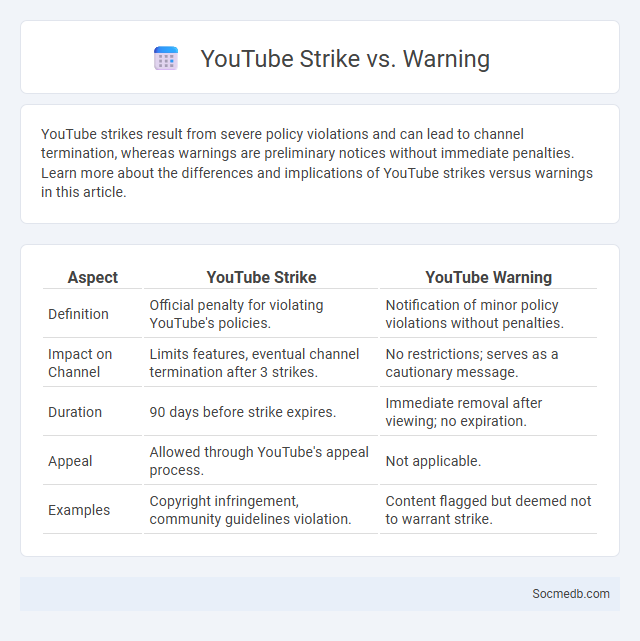
Photo illustration: YouTube Strike vs Warning
YouTube strikes result from severe policy violations and can lead to channel termination, whereas warnings are preliminary notices without immediate penalties. Learn more about the differences and implications of YouTube strikes versus warnings in this article.
Table of Comparison
| Aspect | YouTube Strike | YouTube Warning |
|---|---|---|
| Definition | Official penalty for violating YouTube's policies. | Notification of minor policy violations without penalties. |
| Impact on Channel | Limits features, eventual channel termination after 3 strikes. | No restrictions; serves as a cautionary message. |
| Duration | 90 days before strike expires. | Immediate removal after viewing; no expiration. |
| Appeal | Allowed through YouTube's appeal process. | Not applicable. |
| Examples | Copyright infringement, community guidelines violation. | Content flagged but deemed not to warrant strike. |
Understanding YouTube’s Enforcement System
YouTube's enforcement system relies on a combination of automated algorithms and human reviewers to detect policy violations such as hate speech, copyright infringement, and misinformation. Strikes are issued for violations, with three strikes leading to channel termination, emphasizing the platform's commitment to maintaining community standards. Content creators must familiarize themselves with YouTube's policies to avoid penalties and ensure their videos remain available.
What Is a YouTube Strike?
A YouTube strike is a penalty imposed on your channel for violating YouTube's Community Guidelines or copyright policies, potentially limiting your ability to upload or live stream. Accumulating multiple strikes can result in channel suspension or termination, directly impacting your content distribution and audience engagement. Understanding YouTube strike rules helps protect your channel's longevity and maintain your presence on the platform.
The Difference Between Strikes and Warnings
Social media platforms differentiate strikes and warnings to enforce community guidelines, where strikes represent formal penalties for violations and can lead to account restrictions or suspensions, while warnings serve as preventive notices without immediate punitive effects. Strikes often accumulate over a designated period, triggering escalating consequences such as temporary bans or content removal, whereas warnings merely inform users about potential policy breaches to encourage compliant behavior. Understanding this distinction is crucial for effective account management and maintaining adherence to platform rules like those on YouTube, Instagram, and Facebook.
What Triggers a YouTube Warning?
YouTube warnings are triggered by content violations such as copyright infringement, inappropriate language, hate speech, or harmful misinformation. The platform uses automated systems and user reports to detect breaches of its Community Guidelines, including spam, scams, or violent content. Repeated offenses may lead to strikes, affecting channel monetization and visibility.
How Copyright Strikes Work on YouTube
YouTube's copyright strikes occur when a content owner submits a valid claim against a video that infringes their copyright, triggering an automatic removal or restriction of that content. Each copyright strike remains active for 90 days, during which the channel's features and monetization might be limited, and accumulating three strikes results in channel termination. YouTube's Content ID system helps identify copyrighted material, enabling owners to either block, monetize, or track videos using their copyrighted content.
Impact of Community Guidelines Strikes
Community guidelines strikes on social media platforms significantly influence user behavior by enforcing content standards and reducing harmful activities such as misinformation, hate speech, and harassment. Repeated violations often lead to account suspensions or permanent bans, which incentivizes users to adhere to platform rules and fosters safer online environments. The enforcement of these strikes also helps platforms maintain advertiser trust and comply with regulatory requirements.
Consequences of Multiple Strikes
Multiple strikes on social media accounts can lead to permanent suspension or restricted access, severely limiting your ability to connect with your audience. Platforms such as YouTube, Instagram, and TikTok enforce strict policies that escalate penalties with each violation, impacting content visibility and monetization. Understanding these consequences helps you manage your online presence responsibly and avoid potential loss of channels and followers.
How to Avoid YouTube Strikes and Warnings
To avoid YouTube strikes and warnings, ensure your content complies with YouTube's Community Guidelines and copyright policies by using original material or properly licensed media. Regularly review YouTube's updates on prohibited content to stay informed about changes that might affect your channel. Protect your channel's standing by appealing strikes promptly if you believe they are unjust and maintaining a clear record of your uploads' compliance.
Appealing YouTube Warnings and Strikes
YouTube warnings and strikes play a crucial role in maintaining community guidelines while safeguarding user engagement. Clear, well-designed warnings help creators understand the specific violations, reducing repeat offenses and fostering a safer online environment. Effective enforcement through strikes impacts channel monetization and visibility, encouraging responsible content creation on the platform.
Best Practices for Staying Compliant on YouTube
YouTube compliance requires strict adherence to community guidelines, copyright laws, and advertising policies to avoid channel strikes or removal. Utilizing YouTube's Content ID system and ensuring all uploaded content respects intellectual property rights enhance legal protection. Regularly reviewing updates from YouTube's Creator Academy helps creators stay informed about platform changes and best practices for monetization and content management.
 socmedb.com
socmedb.com